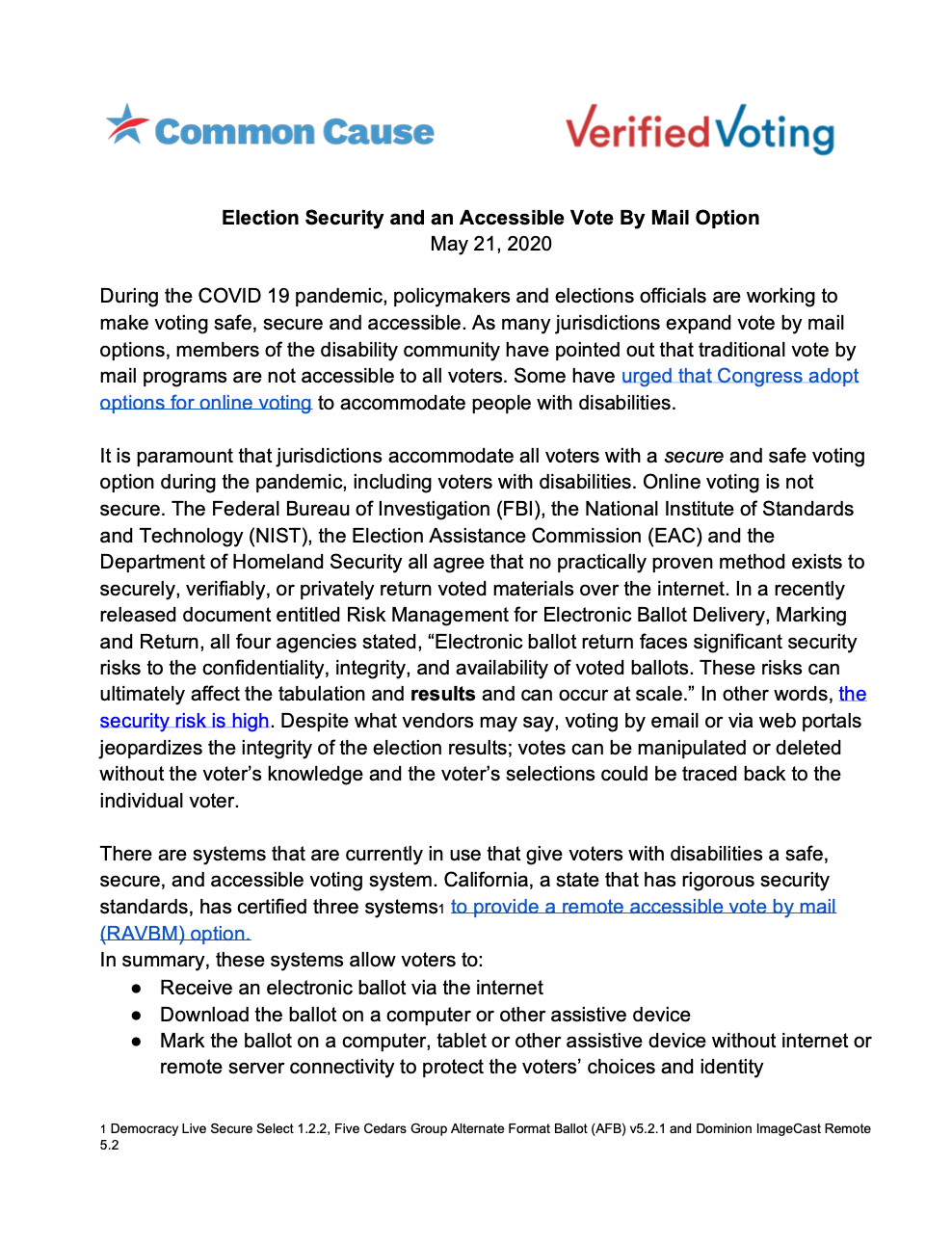
resource
Election Security and an Accessible Vote By Mail Option
Date: May 22, 2020
Author: Verified Voting and Common Cause
Issue: Voting Equipment, Internet Voting, Election Security
Publication Summary
Guidance by Common Cause and Verified Voting outlines that remote accessible vote by mail options that keep voters choices private and secure already exist and should be made available to voters with disabilities as states increase access to vote by mail.
During the COVID 19 pandemic, policymakers and elections officials are working to make voting safe, secure and accessible. As many jurisdictions expand vote by mail options, members of the disability community have pointed out that traditional vote by mail programs are not accessible to all voters. Some have urged that Congress adopt options for online voting to accommodate people with disabilities.
It is paramount that jurisdictions accommodate all voters with a secure and safe voting option during the pandemic, including voters with disabilities. Online voting is not secure. The Federal Bureau of Investigation (FBI), the National Institute of Standards and Technology (NIST), the Election Assistance Commission (EAC) and the Department of Homeland Security all agree that no practically proven method exists to securely, verifiably, or privately return voted materials over the internet. In a recently released document entitled Risk Management for Electronic Ballot Delivery, Marking and Return, all four agencies stated, “Electronic ballot return faces significant security risks to the confidentiality, integrity, and availability of voted ballots. These risks can ultimately affect the tabulation and results and can occur at scale.” In other words, the security risk is high. Despite what vendors may say, voting by email or via web portals jeopardizes the integrity of the election results; votes can be manipulated or deleted without the voter’s knowledge and the voter’s selections could be traced back to the individual voter.
There are systems that are currently in use that give voters with disabilities a safe, secure, and accessible voting system. California, a state that has rigorous security standards, has certified three systems [1] to provide a remote accessible vote by mail (RAVBM) option.
In summary, these systems allow voters to:
- Receive an electronic ballot via the internet
- Download the ballot on a computer or other assistive device
- Mark the ballot on a computer, tablet or other assistive device without internet or remote server connectivity to protect the voters’ choices and identity
- Print the paper ballot at home
- Place the paper ballot in a privacy envelope and then in a mailing envelope
- Cast a ballot by mail or by placing it in a secure drop box or other drop off location
The elements of a secure remote accessible vote by mail option are outlined in CA Election Code Sec 19295. For RAVBM systems to be secure they must be prohibited from allowing the following capabilities, even optionally:
- to use a remote server to mark a voter’s selections transmitted to the server from the voter’s computer via the Internet
- to store any voter identifiable selections on any remote server
- to tabulate vote
- to return the ballot via the internet to the local election office
Without meeting such parameters, a remote voting system is insecure. If state election officials decide to implement one of these RAVBM systems, they should consider the following to support their efforts:
- Collaborate with disability rights groups to educate the public
- Include voter education materials with the absentee ballot application and mail-in ballot packet
- Send all voters who request to use a remote accessible vote by mail method a well–designed privacy envelope and a pre-paid envelope so that voters may mail the ballot or drop it off in one of the drop off locations
To reiterate, states should not turn to other insecure methods such as blockchain voting or internet voting during the COVID-19 pandemic. Remote accessible vote by mail options that keep voters’ choices private and secure already exist and should be made available to voters with disabilities as states increase access to vote by mail. In addition, states should continue to have accessible polling locations open for voters who need or prefer to vote in person during early voting as well as on Election Day.
[1] Democracy Live Secure Select 1.2.2, Five Cedars Group Alternate Format Ballot (AFB) v5.2.1 and Dominion ImageCast Remote 5.2